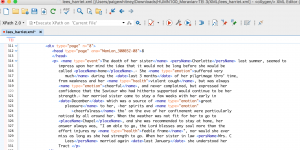The process of marking up the transcription of Harriett Lee’s memoir has positively affected my understanding of the text. After spending this entire semester working with this memoir making transcribing, making timelines, and especially marking up the transcription has allowed me to understand the memoir so much better. Close reading has allowed me to notice and understand the specifics and smaller, hidden information in the text that I did not see earlier and while I was distant reading. This is an example of differential reading, which has helped broadened my understanding of the text and has allowed me to gain a better connection to the text. While transcribing in the beginning of the semester, I was perplexed and uncertain if what I was transcribing made any sense, but as the semester went on and I practiced differential reading, I have learned so much more about Harriett Lee’s life and about the early nineteenth century as well. Our completion of our memoir this far in the semester is an example of a diplomatic edition, “the two products will possibly contain the same text, but while the first will be a private product, the latter will be a publicly published one. These two objects therefore represent two different stages of the same editorial process, although the first can exist without the second” (Pierazzo 646).
My overall understanding of how edited texts are predicted changed drastically when working as an editorial board with Hailey. The process of marking up the memoir of Harriett Lees with Hailey was a slight challenge because we had to make important decisions on what specifically to tag. To ensure consistency in our mark ups, we were constantly discussing our opinions on how and what we should tag. Hailey and I decided to make a google doc to help keep our thoughts organized on what we were and weren’t tagging, which was extremely helpful, especially when doing work outside of class.
One example of a big decision we discussed is if we should tag “God”, “Savior”, and “Lord” as a person. There is much controversy over this because each individual has different thoughts and opinions on this, but after a long discussion, we decided that God should not be tagged as a person. We also agreed to not tag “heaven” as a place for this same reason. Depending on the context of the sentence, we decided to tag “church” as an organization because Harriett Lees’s life revolved around religion. We also decided that tagging “brother”, “sister”, “mother”, “doctor”, etc. as people would not be beneficial when reading this memoir. My favorite part of tagging was tagging emotion because it deepen my connection to the text and how Harriett Lees and her family felt when she was so ill.
Through this process, I have come to notice and learn that “the process of selection is inevitably an interpretative act” (Pierazzo 465).
Hailey and I get along very well and share many of the same values and beliefs, so there has been very little disputes. When a disagreement occurred, we would each explain our reasoning for why we felt a way about marking up the text and then would then compromise on a decision. Our compromise is an example of social agreement that Peter Robinson discussed in the article. The article says, “judgment is necessarily involved in deciding what is in fact present [in the manuscript], as when an ambiguously formed character resembles two different letters; but the transcriber’s goal is to make an informed decision about what is actually inscribed at each point (Pierazzo 466). I think these words are very wise and well thought out.
Editing digital texts is very difficult, but also rewarding. Strong communication between team members is very important to help prevent any mistakes, such as not working on the newest document, from occurring. All in all, I really enjoyed learning how to edit digital texts and am very glad I learned this skill. I also find it fascinating that technology has allowed us to be able to electronically transcribe documents from so long ago.


Paige Whitney is a sophomore at Bucknell University. She is from Darien, CT. She is undeclared, but has interests in psychology, management, and economics.